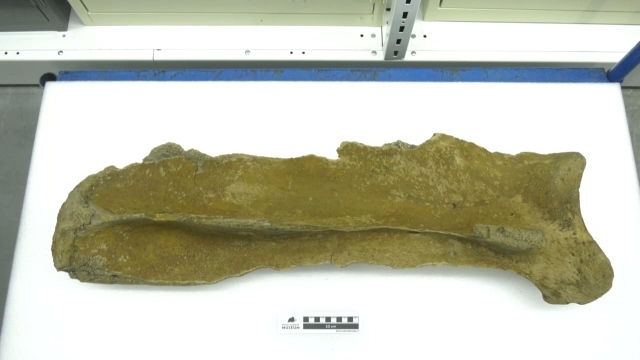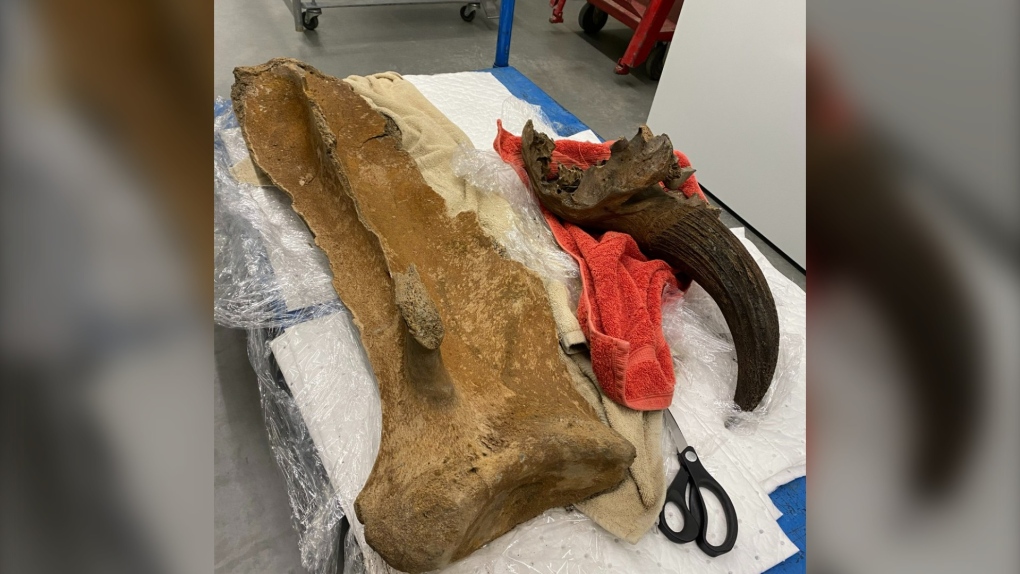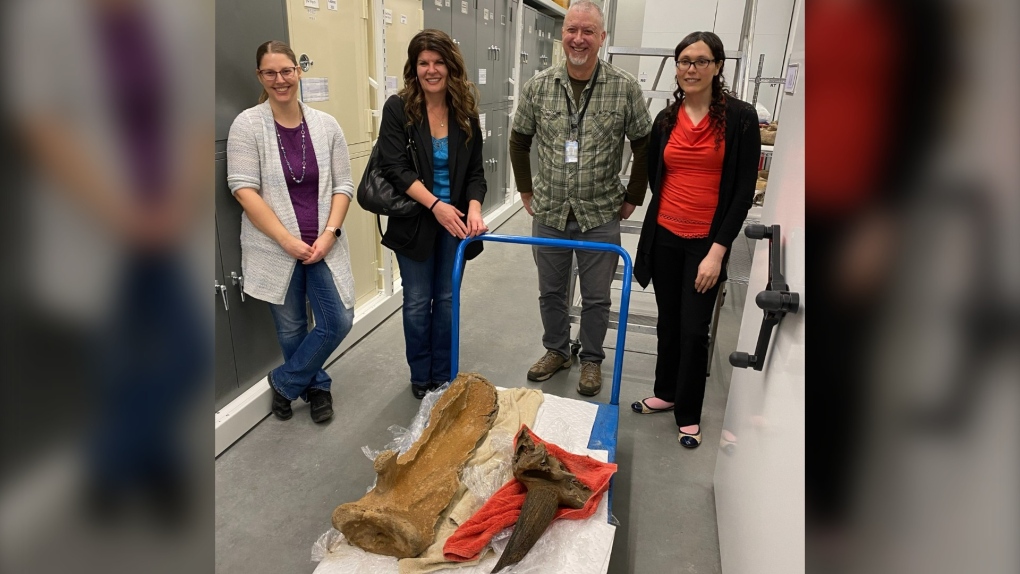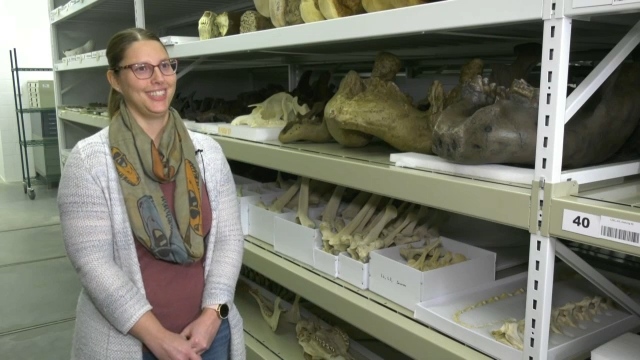Ice Age relic found by Alberta woman out walking her dogs
A chance discovery by an Edmonton area woman who was walking her dogs has turned out to be a massive fossilized bone that likely belonged to an Ice Age mammoth.
Stacy Long was walking out west of Devon last spring when she came across something jutting out of the river bank. That find has now been confirmed to be a fossil relic from the Ice Age, a potential scapula from an adult mammoth.
"On previous trips, there had been nothing," Long said. "This time, there was stuff coming out of the bank."
At first, she thought it was a large piece of wood. Long says she loves finding and collecting rocks for her garden.
"When I rinsed it off, it didn't look like wood anymore," she added. "So I thought, 'Oh, it might be something cool."
 A closeup of the shoulder blade Stacy Long found while walking her dogs west of Devon, Alta. (CTV News Edmonton/Darcy Seaton)
A closeup of the shoulder blade Stacy Long found while walking her dogs west of Devon, Alta. (CTV News Edmonton/Darcy Seaton)
She recalled how her husband was dubious at the time that she found anything exciting.
"I was a humanities teacher, not a science teacher," Long said. "He was just tired of me bringing rocks home for my flower bed."
"He was like, 'It's nothing,' but it ended up being something," she said with a laugh.
BUILDING THE PUZZLE OF ALBERTA'S HISTORY: RAM
She lugged the specimen home and sent a picture to the Royal Alberta Museum. After a series of emails, experts confirmed that Long had found a fossil that was just over a metre long. Long also came across a partial skull believed to be from a Bison antiquus from around the same era.
 The pair of fossils Stacy Long found while walking her dogs west of Devon last spring (Supplied).
The pair of fossils Stacy Long found while walking her dogs west of Devon last spring (Supplied).
Katherine Bramble, a RAM paleontologist, said the bone is believed to be a mammoth shoulder blade that is 10,000 to 14,000 years old. It has since been added to the museum's research and reference collection.
"We will be learning more about it from comparing it to other specimens, other mammoth bones, not just from her but elsewhere and that can tell us more about maybe what species it is," Bramble told CTV News Edmonton.
 Stacy Long (centre left) poses for a photo with Royal Alberta Museum staff, including paleontologist Katherine Bramble (far left) (Supplied).
Stacy Long (centre left) poses for a photo with Royal Alberta Museum staff, including paleontologist Katherine Bramble (far left) (Supplied).
What is now Alberta had two kinds of mammoths during the Ice Age, the larger but not as furry Columbian mammoth and the iconic woolly mammoth, Bramble explained.
Mastodons, which are more closely related to modern elephants, also lived in the area.
"It's too early to tell which species it could be," Bramble said.
For her, the find is exciting since mammoth and mastodon fossils are less common in Alberta when compared to dinosaur bones.
"What we have in the collections are teeth or tusk elements," she added. "We have a couple of arm or leg bones, but we don't have as much as we'd like to have."
Fossils, including the remains of plants and animals or traces of their activity, are protected in Alberta by the province's Historical Resources Act.
"By law, you are not allowed to dig for fossils if you find any," Bramble explained. "You need to have a permit for that."
"If you find something on the surface, you are allowed to collect it and take it home. Our preference would be that you get in contact with us and let us know what you found."
 Royal Alberta Museum paleontologist Katherine Bramble (CTV News Edmonton/Darcy Seaton).
Royal Alberta Museum paleontologist Katherine Bramble (CTV News Edmonton/Darcy Seaton).
Locating a different fossil like the one Long came across is helpful in building the puzzle of Alberta's natural history, Bramble said, like providing more details about where mammoths were living.
This spring, the museum plans to send a team to further probe the area where Long located the mammoth specimen in the hopes of finding more fossils.
"It just grows the story that we've been building over time about how Alberta looked in the Ice Age," Bramble said.
With files from CTV News Edmonton's Jeremy Thompson
CTVNews.ca Top Stories

RCMP uncovers plot to sell drones and equipment to Libya
The RCMP says it has uncovered a plot by two men in Montreal to sell Chinese drones and military equipment to Libya illegally.
Demonstrators kicked out of Ontario legislature for disruption after failed keffiyeh vote
A group of demonstrators were kicked out of the legislature after a second NDP motion calling for unanimous consent to reverse a ban on the keffiyeh failed to pass.
Tom Mulcair: Park littered with trash after 'pilot project' is perfect symbol of Trudeau governance
Former NDP leader Tom Mulcair says that what's happening now in a trash-littered federal park in Quebec is a perfect metaphor for how the Trudeau government runs things.
Man wanted in connection with deadly shooting in Toronto tops list of most wanted fugitives in Canada
A 35-year-old man wanted in connection with the murder of Toronto resident 29-year-old Sharmar Powell-Flowers nine months ago has topped the list of the BOLO program’s 25 most wanted fugitives across Canada, police announced Tuesday.
Doctors ask Liberal government to reconsider capital gains tax change
The Canadian Medical Association is asking the federal government to reconsider its proposed changes to capital gains taxation, arguing it will affect doctors' retirement savings.
Keeping these exotic pets is 'cruel' and 'dangerous,' Canadian animal advocates say
Canadian pet owners are finding companionship beyond dogs and cats. Tigers, alligators, scorpions and tarantulas are among some of the exotic pets they are keeping in private homes, which pose risks to public safety and animal welfare, advocates say.
Thieves use stolen forklift to rip cash machine out of U.K. bank
Police in the U.K. are searching for a group of suspects seen on video using a forklift to steal a cash machine from a bank.
'There was a lot of black smoke': Crane operator sounds alarm while trapped during highrise fire in Halifax
A tower crane operator alerted emergency crews after noticing a fire on a construction site in Halifax Tuesday morning.
Cherry blossoms blooming in Canada: Here's what to know
There is a swaying sea of colour in some cities across Canada, and it's a sure sign of spring: cherry blossoms are in bloom.






























